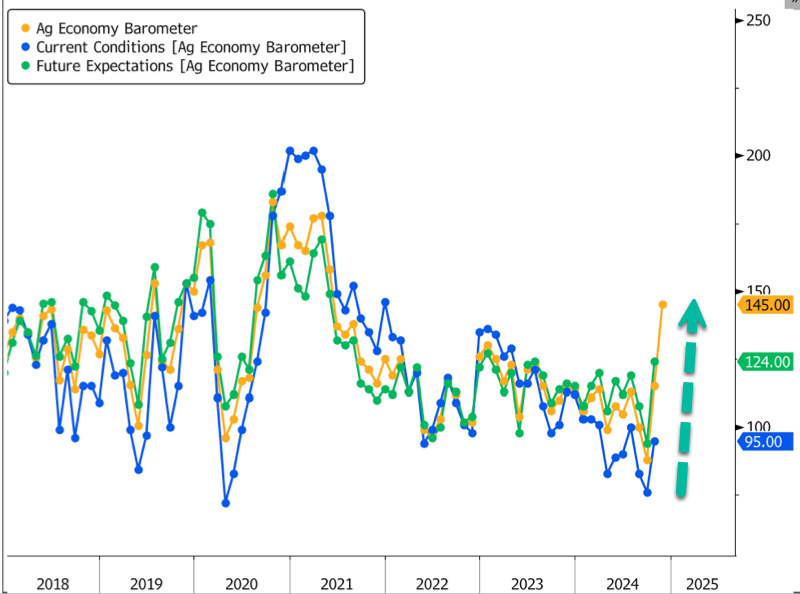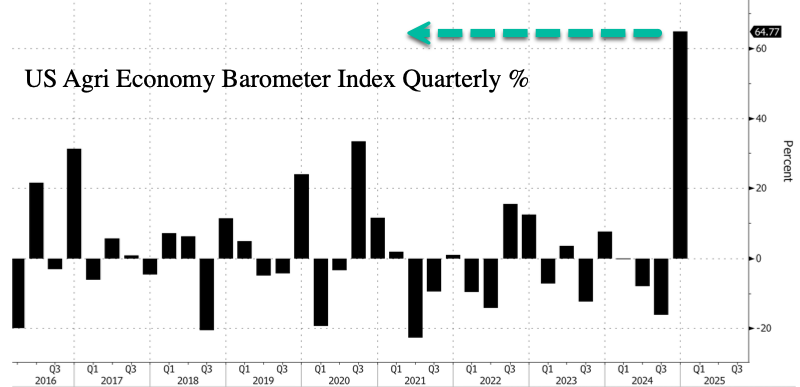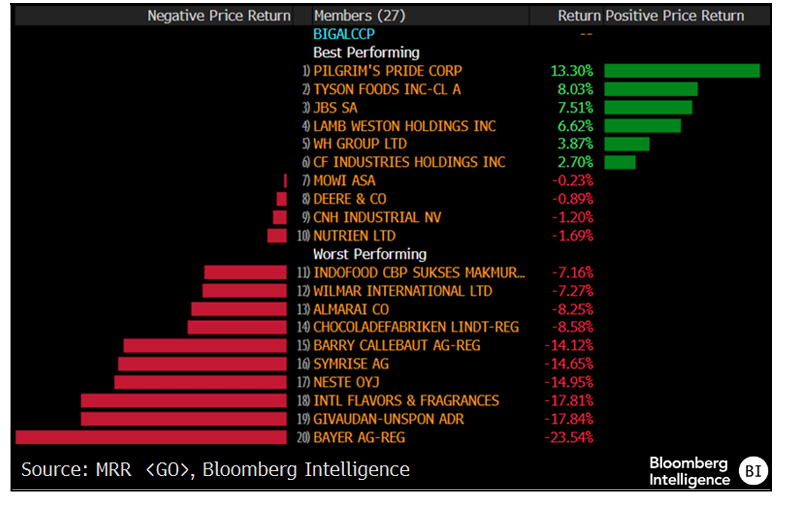US Farm Sentiment Set For Largest Quarterly Rise On Record
Sentiment among US farmers plummeted in the months leading up to the election but surged in October and November as it became clear that President Trump was poised to win. If sustained, this multi-month surge could record the largest quarterly boost in farm sentiment on record despite trade war threats with China and challenging operating ag environments.
"Apparent relief over the US presidential election has boosted farmers' sentiment," Bloomberg Intelligence's Jason Miner and Ama Kyerewaa wrote in a note, adding, "Even so, looming trade friction could worsen still low-crop prices. High rents add pressure to the farm financial outlook, while debt-service burdens are set to rise as loans roll over amid higher interest rates."
In September, the Purdue University-CME Group Ag Economy Barometer Index tumbled to its lowest readings since March 2016, a time when the farm economy was a mess. This was primarily due to sliding commodity prices and soaring costs, pressuring farmer incomes.
However, the Ag Economy Barometer, a survey of 400 farmers across the nation, skyrocketed in October and November, on the prospects of Trump restoring the ag industry to greatness in his second term.
"With little change in input costs or still-low crop prices since October, the November result is a reminder of support for Trump among US farmers," BI analysts noted.
They said, "Producers were optimistic about lower tax and environmental regulatory burdens on the agriculture economy in the year ahead. Sentiment around future conditions rose more than for current ones. Appetite for capital investment significantly improved alongside a rise in expectations for farm financial performance in 2025."
If farm barometer readings remain elevated through year-end, the fourth quarter would lock in the largest quarterly gain on record, with data going back to 2015.
Despite the euphoria surrounding Trump, farmers remained deeply concerned about the potential impact of a trade war with China, with about 42% of respondents citing it as a major concern.
BI analysts provided more color on the ongoing challenging macroeconomic backdrop for farmers:
USDA Farm Debt Looms as Repayments
Fall US farms' debt is poised to reach a record in 2024, according to the USDA. Significant increases in real estate debt have boosted the total, while other debt remains roughly steady. Strong repayments look less likely in the coming year as cheaper crops drive down revenue. Fixed interest rates for farms have risen roughly 400 bps since 2022, according to the Kansas City Fed, making higher costs likely as loans roll over. Though long-duration (greater than three years) real estate loans peaked near 80% in 2021, according to Farmer Mac, this leaves many to expire in 2025
Rising land values create a stubborn cost problem, affecting multiyear mortgage payments and raising rents for those who don't own. Liquidity is already falling in late 2024, and the pace of repayments is declining.
USDA Farm Debt Relative to Net Cash Income
Farm Credit Data Weaken Toward 2020 Levels
Higher Farm Rents Add Pressure on Farms
Farmland rental rates have a significant impact on growers' profits. Land costs comprise around one-fifth of the gross value of corn production, and over half of US cropland is rented. At $160 an acre, the USDA-NASS survey for 2024 shows average US cropland rent is 3% higher vs. 2023 and 11% above the five-year average. Across the top 10 corn-producing states, 2024 cropland cash rent ranged from $75 in Kansas to $276 in Iowa. On average, cash rents in these states rose to $191 an acre, up 3% alongside the national average. Crop yields largely account for the differences between states. Irrigated land rented for an average premium of $58.
Rising rents look likely to remain a key concern, as most farmers surveyed by the Purdue Center for Commercial Agriculture expect cash rents to either stay the same or increase in 2025.
2024 Cash Rents Above Historical Averages
Farm Rent Consensus Shows Little 2025 Decline
Protein Shares a Lone Spot of Strength
As weaker crop prices extend, the underperformance of equities in the Bloomberg Intelligence upstream agriculture peer group has persisted against downstream peers since the start of 2024. Both groups are lower and have trailed equities, with the MSCI All Country World Index up 18% in 2024. Over the past month, gains are more common downstream among buyers of crops in protein (BRF, Pilgrim's Pride, JBS) ingredients (Ingredeon, Balchem) or food (Marfrig, Cal-Maine). Downstream performance is restrained by weak consumer demand and a softer margin outlook for biofuels producers (Neste, Verbio).
Upstream producers are faring worse, down a median 4% vs. up 3% for downstream. Share declines are nearly universal among upstream players that sell chemicals (FMC, Nutrien, Corteva) and equipment (CNH, AGCO, Deere) to farmers. (11/15/24)
There's more good news for America's farmers.
MAHA's Nicole Shanahan Shares Vision To Make Small Farms Great Again https://t.co/0bhGGZKlw5
— zerohedge (@zerohedge) November 15, 2024
It's time to restore the power back into small farms and break the stranglehold of mega-corporations over the food supply chain, which has become increasingly harmful to both our health and the environment.
NEVER MISS THE NEWS THAT MATTERS MOST
ZEROHEDGE DIRECTLY TO YOUR INBOX
Receive a daily recap featuring a curated list of must-read stories.










